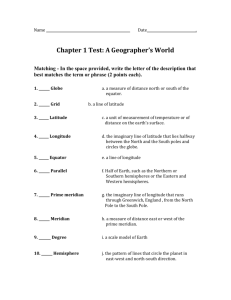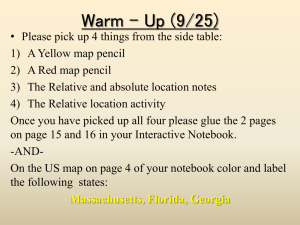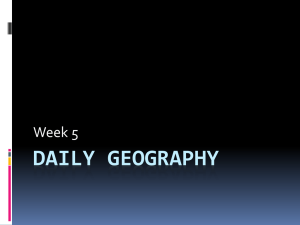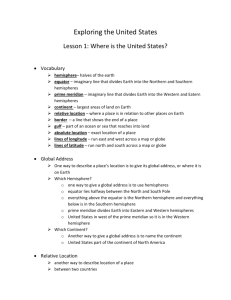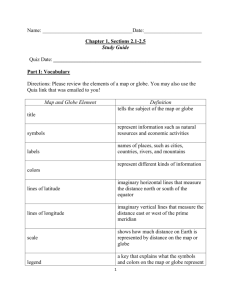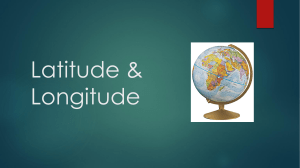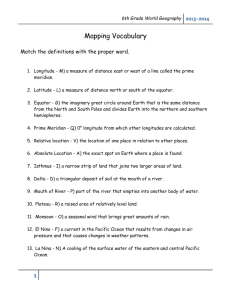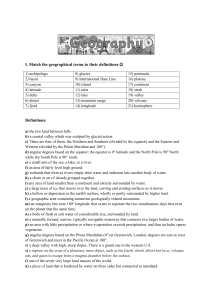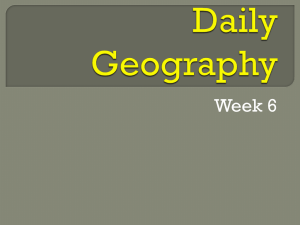- Sparks High School
advertisement
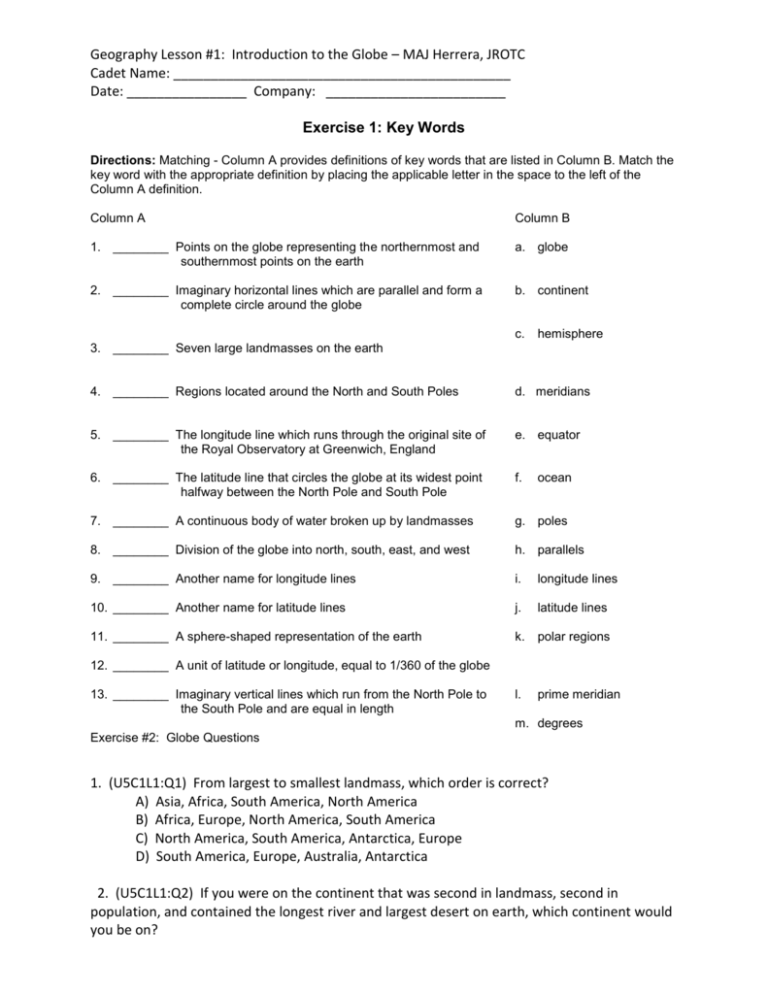
Geography Lesson #1: Introduction to the Globe – MAJ Herrera, JROTC Cadet Name: _____________________________________________ Date: ________________ Company: ________________________ Exercise 1: Key Words Directions: Matching - Column A provides definitions of key words that are listed in Column B. Match the key word with the appropriate definition by placing the applicable letter in the space to the left of the Column A definition. Column A Column B 1. ________ Points on the globe representing the northernmost and southernmost points on the earth a. globe 2. ________ Imaginary horizontal lines which are parallel and form a complete circle around the globe b. continent c. hemisphere 3. ________ Seven large landmasses on the earth 4. ________ Regions located around the North and South Poles d. meridians 5. ________ The longitude line which runs through the original site of the Royal Observatory at Greenwich, England e. equator 6. ________ The latitude line that circles the globe at its widest point halfway between the North Pole and South Pole f. 7. ________ A continuous body of water broken up by landmasses g. poles 8. ________ Division of the globe into north, south, east, and west h. parallels 9. ________ Another name for longitude lines i. longitude lines 10. ________ Another name for latitude lines j. latitude lines 11. ________ A sphere-shaped representation of the earth k. polar regions l. prime meridian ocean 12. ________ A unit of latitude or longitude, equal to 1/360 of the globe 13. ________ Imaginary vertical lines which run from the North Pole to the South Pole and are equal in length m. degrees Exercise #2: Globe Questions 1. (U5C1L1:Q1) From largest to smallest landmass, which order is correct? A) Asia, Africa, South America, North America B) Africa, Europe, North America, South America C) North America, South America, Antarctica, Europe D) South America, Europe, Australia, Antarctica 2. (U5C1L1:Q2) If you were on the continent that was second in landmass, second in population, and contained the longest river and largest desert on earth, which continent would you be on? A) B) C) D) Africa Asia North America South America 3. (U5C1L1:Q3) If you were on the continent of Antarctica, which ocean could you not travel on to get directly to another continent? A) Arctic Ocean B) Atlantic Ocean C) Pacific Ocean D) Indian Ocean 4. (U5C1L1:Q4) If you were at zero degrees latitude, where would you be? A) The North Pole B) The South Pole C) Greenwich, England D) On the Equator 5. (U5C1L1:F1) A unit of latitude or longitude, equal to 1/360 of the globe is called a(n) _____. A) meridian B) equator C) degree D) pole 6. (U5C1L1:F2) What are the seven large landmasses on the planet called? A) continents B) globes C) hemispheres D) oceans 7. (U5C1L1:Q5) Asia is the largest continent in _________. A) size B) population C) mineral wealth D) size and population 8. (U5C1L1:V1) Choose the term that best completes the sentence below. A(n) __________ is one continuous body of salt water that is broken up by landmasses. A) equator B) polar region C) ocean D) parallel 9. (U5C1L1:V2) Choose the word that best completes the sentence below. The imaginary line at 0 degrees latitude that circles the globe at its widest point halfway between the North Pole and South Pole is known as the __________. A) equator B) meridian C) parallel D) continent 10. (U5C1L1:V3) Choose the term that best completes the sentence below. The United States is in the Earth's northern _________. A) prime meridian B) latitude C) degrees D) hemisphere 11. (U5C1L1:V4) Choose the word that best completes the sentence below. An imaginary circle on the Earth’s surface passing through the North and South poles is called the __________. A) equator B) meridian C) poles D) continent 12. (U5C1L1:V5) Choose the term that best completes the sentence below. The areas surrounding the North and South poles are known as ________. A) polar regions B) oceans C) hemispheres D) globes 13. (U5C1L1:V6) Choose the term that best completes the sentence below. _________ are units of latitude or longitude that are equal to 1/360 of the globe. A) Continents B) Prime meridians C) Oceans D) Degrees 14. (U5C1L1:V7) Choose the word that best completes the sentence below. The Earth's __________ are located at each end of the Earth's imaginary axis. A) hemisphere B) poles C) equator D) longitude 15. (U5C1L1:V8) Choose the term that best completes the sentence below. In 1884, the ___________ or the longitude line numbered 0 degrees, was established at an international conference. A) poles B) latitude C) prime meridian D) continent 16. (U5C1L1:V9) Choose the word that best completes the sentence below. Lines of __________ run north to south, meeting at the poles. A) B) C) D) equator longitude latitude parallel 17. (U5C1L1:V10) Choose the word that best completes the sentence below. South America, one of the planet's seven large landmasses, is known as a ___________. A) degree B) latitude C) pole D) continent 18. (U5C1L1:V11) Choose the term that best completes the sentence below. A(n) _________ is a sphere-shaped model of the earth. A) globe B) hemisphere C) prime meridian D) ocean 19. (U5C1L1:V12) Choose the word that best completes the sentence below. Lines of _________ run east to west around the globe. A) poles B) latitude C) meridians D) longitude 20. (U5C1L1:V13) Choose the word that best completes the sentence below. Lines that do not intersect are known as ________. A) continent B) perpendicular C) degrees D) parallel Lesson Review: 1. List the seven continents and four ocean by size. ______________________________________________________________________________ ______________________________________________________________________________ ______________________________________________________________________________ 2. What is the purpose of the longitude and latitude lines on a globe: ______________________________________________________________________________ ______________________________________________________________________________ ______________________________________________________________________________ 3. What do the North and South Poles represent: ______________________________________________________________________________ ______________________________________________________________________________ ______________________________________________________________________________ 4. Explain the difference between the equator and the prime meridian: ______________________________________________________________________________ ______________________________________________________________________________ ______________________________________________________________________________
